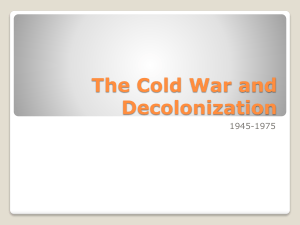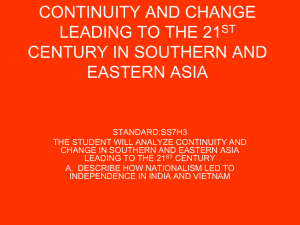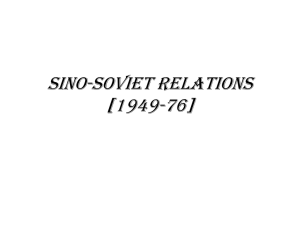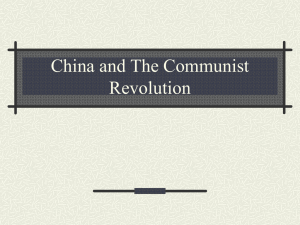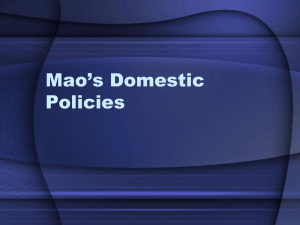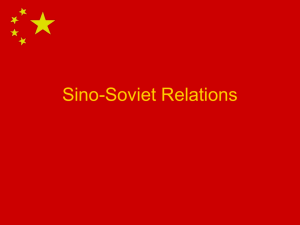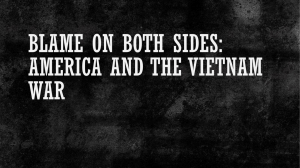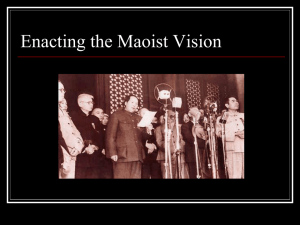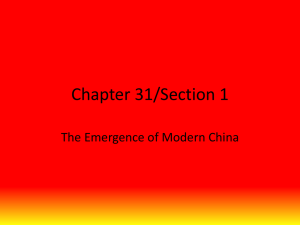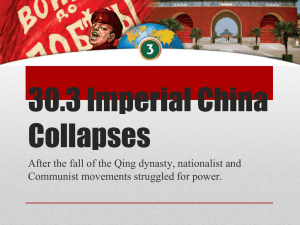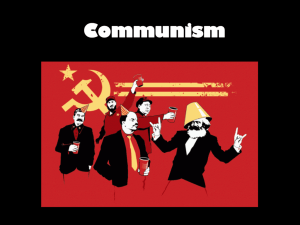topic_1_china_powerpoint_ntt
advertisement
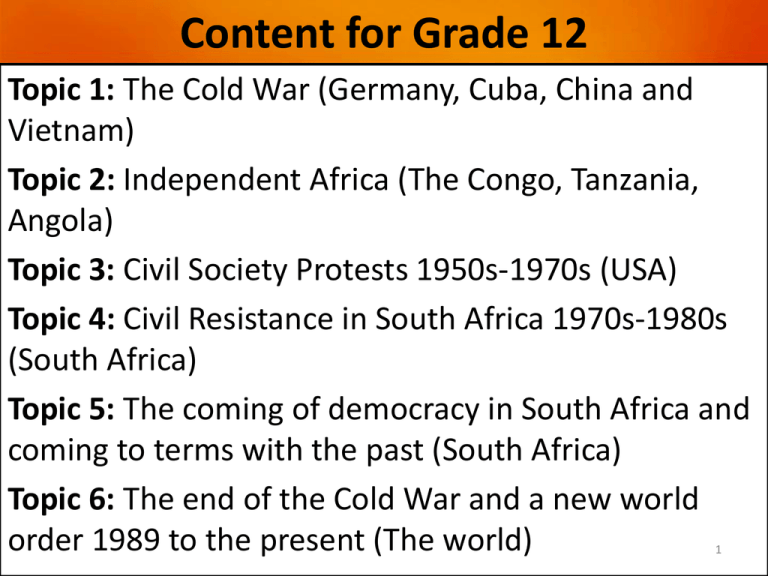
Content for Grade 12 Topic 1: The Cold War (Germany, Cuba, China and Vietnam) Topic 2: Independent Africa (The Congo, Tanzania, Angola) Topic 3: Civil Society Protests 1950s-1970s (USA) Topic 4: Civil Resistance in South Africa 1970s-1980s (South Africa) Topic 5: The coming of democracy in South Africa and coming to terms with the past (South Africa) Topic 6: The end of the Cold War and a new world order 1989 to the present (The world) 1 Topic 6: Globalisation Topic 3: USA Topic 2: Tanzania, The Congo, Angola Topic 1: Germany Cuba, China, Vietnam Topic 4 and 5: South Africa 2 Topic 1: The Cold War Origins of the Cold War (Overview) • The End of World War II – Why did Cold War develop? • USSR and USA and the creation of spheres of interest: - Instillation of the Soviet – friendly governments in satellite states; - USA’s policy of containment: Truman Doctrine and Marshall Plan; - Berlin Crises from 1949-1961 (broad understanding of the crises); and - Opposing military alliances: NATO and Warsaw Pact (broadly) • Containment and brinkmanship: the Cuban crisis and • Who was to blame for the Cold War? 3 Extension of the Cold War Case Study: China How did China rise as a world power after 1949? 4 Where in the world is China? Events leading up to the Communist takeover in 1949 Mao Zedong led the Communist Revolution in China in 1949 and remained China’s leader until his death in 1976. 1927-1949: Chinese civil war fought between Nationalists (Chiang Kai-shek) and Communists (Mao Zedong) During WWII: Both USSR and USA supported nationalists and recognised this govt as official Chinese government. 1949: Mao defeated Chiang’s forces. Communist Party took power. The People’s Republic of China was established. China under Communist Rule Economic Changes • Collective farms replaced private ownership. • 1953-57: 1st five-year plan (aimed to promote industrialisation) • 1958-62: ‘The Great Leap Forward’. Mao’s plans to industrialise China resulted in mass famine. An estimated 20 million people died. The policy was abandoned. • After 1976 : China embraced aspects of capitalist economy. Social Changes • New emphasis on improving the health, welfare and literacy of the majority peasant population. • Literacy increased from 20% in 1949 to 90% by mid1960s. 8 The Cultural Revolution (1966-1976) The Aims of the Cultural Revolution were to: • Reinforce communist principals. • Re-establish Mao’s authority as leader of China Chairman of the Communist Party (NB: context of Mao’s failed Great Leap Forward). • Prepare China’s youth to inherit socialism. • Purge China of the four ‘Olds’: Old customs, old culture, old habits, old ideas. The Cultural Revolution (1966-1976) The Outcomes of the Cultural Revolution: • Students (and later workers and soldiers) were organised into Red Guards whose aim was to identify and root out ‘anti-revolutionary’ and ‘bourgeois’ actions, individuals or artefacts. • Hundreds of thousands of Chinese (many educated and skilled) were accused of being enemies of the state and executed. • Any work considered ‘anti-communist’ was destroyed: books, art, music, monuments. 10 China’s Relations with the USSR (1949-1973) • 1950: USSR signed a 30-year friendship treaty with China. • USSR sent engineers and technicians to assist with industrialisation. BUT • Despite a shared communist ideology, China and USSR were deeply distrustful of each other. • Conflict over borders and territory in Manchuria. • China criticised Khrushchev (Soviet leader after 1954) for proposing ‘peaceful co-existence’ with west. • In 1960 USSR withdrew aid and advisors from China. • The breakdown in the relationship between China and USSR was called the Sino-Soviet split. NB: The split between China and USSR has influenced China’s foreign policy and relations with neighbouring countries. China’s Relations with the USA (1949-1973) • In 1949 USA refused to officially recognise communist China (believing China took orders from USSR). • USA continued to recognise Chiang Kai-shek’s government in exile in Formosa (Taiwan) as the legitimate Chinese government and opposed China’s entry into UNO. • China supported North Korea against South Korea (who were supported by USA) during the 1950-53 war. • After 1960 Sino-Soviet Split China was keen to improve diplomatic and relations with USA. • In 1972 Nixon became the first American President to visit Communist China – diplomatic and trade restrictions eased between the two countries. 12 • China became America’s ‘most favoured trading nation’ China’s relations with neighbouring states Tibet India • China invaded Tibet in 1949 and has occupied the country ever since. • Tibetan Buddhist monks attacked, monasteries destroyed, and culture suppressed. (1959 Dalai Lama went into exile in India.) • Human rights abused by Chinese in Tibet continue • USA and most countries recognise Chinese control over Tibet • 1949 India recognised Communist China • 1962 a border war broke out between India and China. (India lost 20km) • China has consistently backed Pakistan in its wars against India (which has been backed by USSR). • China and India are now both members of BRICS (Brazil, Russia, India, China, South Africa) China’s Relations with neighbouring states Vietnam • China gave Vietnam military assistance during their war of independence from France (1946-54) • China stopped aid to Vietnam when they invaded China’s ally, Cambodia in 1976 and then signed a treaty with USSR in 1978. • In 1979 a border war broke out between China and Vietnam. • Since the end of the Cold-war relations have improved. Taiwan • Chiang Kai-shek fled to this island off the coast of China after Mao had defeated him in 1949. • They declared themselves the official China. • USA provided military and financial aid to Taiwan. • Today Taiwan and China are major trading partners although tensions remain. To what extent was China a superpower by the time of Mao’s Death in 1976? • An economic superpower? Despite trade links with newly independent African and Asian countries China’s economy was weak in 1976. • A military superpower? In 1964 detonated its first atomic bomb but the army was large and unspecialised. • A political superpower? Chinese model of socialism, ‘Maoism’, exported to many peasant based societies in Africa and Asia. • A cultural superpower? Not yet. Conclusion: China after Mao • 1977 Deng Xiaoping took control of China – he moved away from the hardline style of Mao’s communism to ‘Socialism with a Chinese face’. • Capitalist principals (such as private ownership and production for profit) introduced to encourage economic development. • Foreign trade and investment was encouraged. • The military was modernised and streamlined. Conclusion: China after Mao At the end of the 19th Century, European countries were the dominant economic powers. The USA has been the dominant global economic power for the last 50 years. It has been predicted that by 2030 CHINA will have the largest share of the global economic power. With USA second and India third. Source accessed at: http://www.economist.com 17 /node/21528591 Extension of the Cold War Case Study: Vietnam How was a small country like Vietnam able to win a war against the USA? (1954 to 1975) 18 Stages in the War • Background • 1957 to 1965 – Struggle in Vietnam between the South Vietnamese army and the communist-trained rebels (Viet Cong) • 1965 to 1969 – North Vietnamese-USA struggle • The war from the Vietnamese and USA perspective • The war as a global issue • 1969 to 1975 – USA withdrawal from Vietnam and • Conclusion 19 Activity 4.3: Assessment • Instructions: • In groups of 2 to 3 construct 3 Essay Questions which could be used to assess the topic on China (p.25 CAPS). • Each of the essay questions must engage with and use the historical concepts identified on p.10 of the CAPS documents. • Each question must also be examinable using the criteria identified in the global assessment rubric on p.41 of the CAPS documents from L1–L7. • Each question you design should identify which instruction words or subject specific terminology the learner may find challenging and suggest strategies to address this in a classroom context. • Refer to the glossary in the resource pack. THANK YOU! 21
